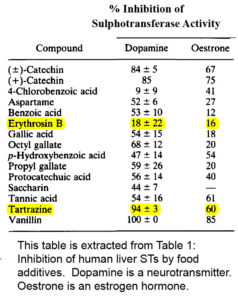Detoxification enzymes provide the means for inactivation, transport and excretion of the xenobiotics including food dyes. Sulfate conjugation is one of the important methods of handling these compounds.
Not only are the synthetic food dyes and other xenobiotics managed via sulfation, but so are some of the neurotransmitters, such as steroid hormones and monoamine neurotransmitters. The required enzymes are called phenolsulfotransferases (PST) and – more recently – SULT1A.
Bamforth wrote that the observed inhibition of M-PST enzyme activity by food additives suggests a possible mechanism for behavioral side effects associated with exposure to these food additives.
In the table at right, you can see that Red 3 and Yellow 5 (highlighted) inhibit sulfotransferase activity. Other additives in the list are also potent inhibitors and it is interesting that most of them are eliminated on the Feingold diet.





















